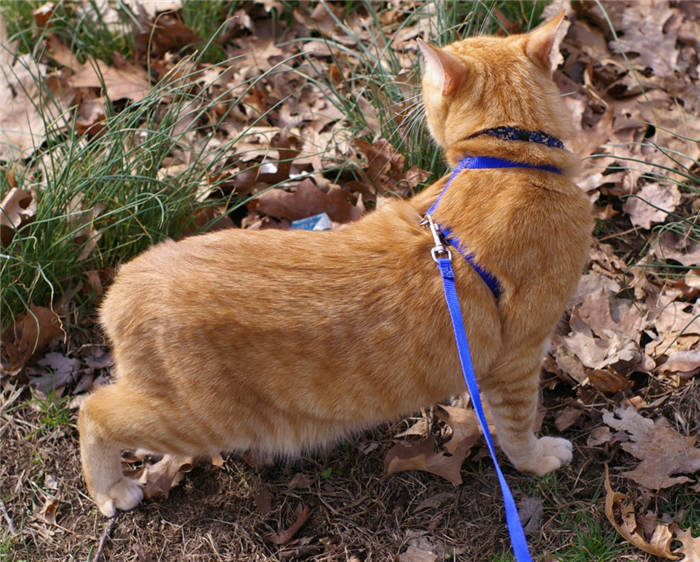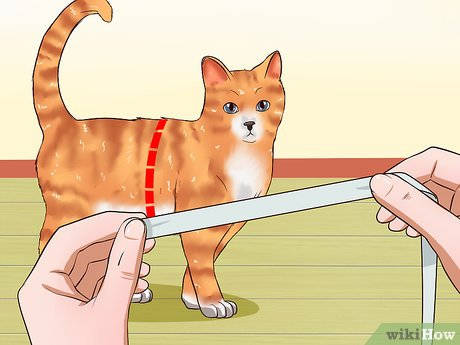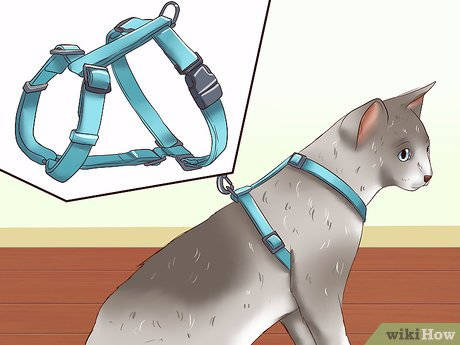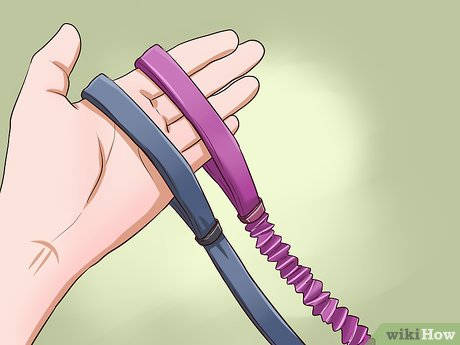7. By indulging your cat's desire to escape outside, you reinforce the behavior she once forced on you: yelling loudly, scratching at doors, trying to escape, etc. In other words, the cat will quickly learn that you can be manipulated and will take advantage of it.

- How to teach a cat to walk on a leash
- Cats and new territory
- What can happen while walking with a harness
- How to train a cat to a harness
- How to choose a harness
- Should you walk your cat outside?
- Letting the cat go for a walk by herself
- Rules for walking a cat on a leash
- Does the cat need the street at all?
- Walking your cat on a leash. Arguments for and against
- Cats walk on a leash differently than dogs
- Maine Coon
- Bengal
- Which pets are not recommended for walking
- How to prepare a cat for walks
- How do I start walking with the cat?
- Safety rules for walks with your cat
How to teach a cat to walk on a leash
We are all well aware of the fact that it is safest for a cat to be away from predators, diseases and cars, within the walls of our warm apartment or home. Walking a cat on a harness is an exception that can be a great way to allow your cat to enjoy walks while being relatively safe.
Walking is very beneficial for some indoor cats. The main condition for usefulness is that the cat must be able to enjoy the walks!
– To spend the excess energy that builds up during the day and can cause problematic behavior;
– A cat that is not afraid of the outdoors will easily tolerate a trip to the house or the vet.
It takes a certain amount of patience to teach a cat to walk on a leash.
Many experts urge us to only use harnesses designed for cats. They may be right to some extent, but personally I am comfortable using dog harnesses as well, you just need to know exactly how to choose the right dog harness for a cat!
There are thousands of harnesses on the market, but far fewer are designed specifically for cats. So why limit yourself in your choices? You can choose a harness made of straps, in the form of a jacket or in the form of a holster. Look for harnesses that have a leash tie mid-back rather than around the neck, which is safer for your cat. Never use a dog bowline harness, the cat will get out of it easily! Never attach a leash to a cat collar! Most cat collars have a safety release that unfastens if you pull hard enough. If this collar comes undone on a walk, your cat will run away. I also highly recommend attaching an address tag with your contact information to your cat's extra collar. Also, under no circumstances should you attach a leash to this collar. The ideal is a cat in a harness or harness-coat with a leash attached and an additional collar with an address tag around the cat's neck. You can buy a collar that is thinner than the dog collar and does not restrict the cat's movements.
Cats and new territory
Walking is absolutely forbidden. You may object: But what about walking on the harness! The owner will be there all the time, the cat won't run away with the harness, and it will look so much outdoors! What's wrong with that?!
Alas, this does not negate the most important thing. First of all, that, as we have already said, cats do not aspire to "see so much". They don't need to develop new territory, the main thing for them is to have and maintain their own. Second, For a domestic cat being outdoors is stressful in any case. Cats in general are conservative by nature, they accept changes with difficulty, and do not try to experience novelty just for the sake of novelty. Needless to say, that if you take the cat out of the familiar environment (at home) and send it to an unfamiliar street, you literally plunge it into everything new.
The loss of its territory, the strange rope wrapped around its neck and chest, hundreds of new smells, sounds, forced acquaintances with people and animals encountered on the way, are bad for the psyche and physical health. And stress is very destructive to cats and easily provokes the activation of hidden problems or, by weakening the immune system, makes the body vulnerable to infections.
So, there is no need for cats to explore something new, but you can easily get stress (and different diseases in the background) because of it. In addition, walking a cat on a harness is not as safe as it may seem.
What can happen while walking with a harness
What is a harness? Basically, just a strap that covers the chest and back for the owner to hold onto. There is no guarantee that even with a harness, your kitty will always be with you and that you will always be in control. So, what can happen:
1) A stray or just 1) A stray or just an unbehaved dog1. A stray or a dog left unattended by the owner may attack the cat and either jump the nearest tree or you will have to rescue it. In the first case you will have to try to get rid of the cat from the tree, especially if you suddenly let the harness out of your hands. In the second – you can get hurt yourself, and quite badly.
2) Unnoticed from you the cat can eat the poison bait. (or it will happen too quickly for you to interfere). This will most likely result in the pet's painful death. Some baits are just enough to be sniffed to cause serious poisoning.
3) Even under your supervision, a frightened cat can suddenly …and suddenly lunge under the wheels… of a car. Given that many people are not too careful to observe the speed limit in the yards, you are unlikely to have time to react.
4) Speaking of sudden jerking, a cat can just Run away on a walk and get lost. The same can happen because of poor quality or poorly secured harness. The result is the loss of a beloved pet and all the risks of walking out at once.
5) Ticks, fleas and lice will be happy to find a new home in the thick fur of your pet, so you should regularly treat your cat against external parasites (drops, a special collar), and closely examine it for ticks after each walk. There is also an increased likelihood of a cat getting worms, so preventive treatments should be done more often.
Read about treatments for external parasites: How to treat a cat for parasites
6. A harness and a nearby host will not guarantee a cat's protection from infections. In addition, some dangerous diseases may be resistant to vaccination, and there are no vaccinations for others. There are different animals outdoors, both healthy and sick. A number of viruses, bacteria, fungi and protozoa are extremely easily transmitted from cat to cat even without direct contact. Stepping on something and licking a paw is enough. On the other hand, you may encounter an aggressive or just sick animal, which will infect your cat with something unpleasant through a bite or other kind of contact.
How to train a cat to a harness
This article is co-authored by Molly DeVoss, our regular contributor. The regular contributors to wikiHow work closely with our editors to ensure that the articles are as accurate and complete as possible.
A harness-trained house cat gets a terrific opportunity to walk safely outside. If you train your pet to a harness, you will later be able to let your cat walk outside on its own. When training your cat to walk on a leash, it's important to remember that initially the outdoor environment can be overwhelming to a cat used to home. If your pet becomes anxious or even panicky at first, be compassionate and patient with him. It will take some time for the cat to become comfortable in the harness itself and on outdoor walks, so take your time and remember to always encourage the cat with generous praise and plenty of treats. In this article, we will tell you in detail about how you can train your cat to a harness for safe outdoor walks and exploring the world around him.
How to choose a harness


- A harness that fits well should fit around the cat's body without squeezing or cutting into it, and should not sag anywhere. If properly sized, only a couple of fingers can be slipped under the pet's harness.
- Never use the harness as a restraint for car rides. Harnesses are not designed to protect cats in the event of an accident.

- Some manufacturers make lighter leashes specifically for cats, since cats themselves are usually lighter in weight and not as strong as dogs.
- Elastic leashes are ideal for cats and stretch well enough to allow the cat to move around safely.
- Do not use leashes (designed for dogs), as they are not suitable for cats at all and may even traumatize your cat.
Should you walk your cat outside?
Introverted cats can play inside their apartments and talk to their owners. Such animals do not feel imprisoned and they only need to spend a couple of hours near a window to enjoy contact with the outside world. If a cat has never been outside and does not show any interest in its surroundings you should not take it out forcibly, since it will not like such a gesture.
Curious cats, who always try to sneak out the door, will accept the walk enthusiastically. For them the outdoors will do them good and will satisfy their need for new experiences. But do not rush to get the harness: for the first exit in the world, you need to prepare carefully, so that the walk was comfortable and safe.
Note that not all pets can be walked. Even if your pet is eager to go outside, check if he is in the "risk group".
- Unvaccinated kittens aged 3-6 months. Babies have no immunity to disease, and contact with the outside world can be deadly for them. You don't have to go outside to give your kitten a new experience. Treat your kitten to PRO PLAN® BABY KITTEN – a soft mousse with chicken which will delight him and provide him with all the necessary vitamins and minerals;
- Animals vaccinated less than two weeks ago. Their bodies are still weak and their immunity to disease has not yet been formed;
- Vigilant animals that are unpredictable about their behavior outside their homes;
- Pregnant and nursing cats as well as cats in heat. When a cat breeds, it needs special care: give it a quiet and peaceful place where it feels safe and take care of a balanced diet. Try PRO PLAN® DELICATE for Kittens, which will give your cat the extra calories and nutrients she needs during pregnancy and lactation;
Letting the cat go for a walk by herself
If you have a private home, independent travel can be a good equivalent to walking on a leash. But important nuances should be taken care of:
A tight fence and no crevices will keep the cat from encroaching on unwanted territory and prevent other animals from entering the yard;
- Make sure there are no poisonous or toxic plants in the walking area that the cat can eat;
- Treat your pet with a prolonged flea and tick repellent;
- Stay with the cat during walks. The animal will feel more comfortable and you will be able to control its movements.
Walking in the "wild" has certain risks. A pet can get injured in a fight with other animals, get hit by a car, or get lost. There is also a high probability of contracting infectious diseases such as feline leukemia or immunodeficiency virus. So we advise not to take any chances and to walk the cat only under close supervision.
Rules for walking a cat on a leash
Before introducing the pet to a new world, it is necessary to prepare both the owner and the animal. There are a few rules that will make the walk safe and comfortable:
To walk a cat, you will need A harness и leash ..
A harness is a band that covers part of your pet's back and chest. When choosing a harness, it should be based on the size, age and texture of the cat's fur. The accessory should fit snugly on the torso so that the cat cannot get out of it on its own. Also, it should not hinder the movements, squeeze the body and cause discomfort.
When choosing a leash, pay attention to its length: the leash should allow the cat to move within the radius of 2-2.5 m.
You should not force a harness on your cat: the accessory should be associated with positive emotions. Let your pet sniff the harness, touch it, and play with it. Every time the cat shows interest in the accessory, encourage it with a treat or affection.
Does the cat need the street at all?
Or maybe your cat is completely satisfied with life in the apartment and not eager to go on adventures. We have such a cat in our pack – Marquis. He is not interested in the street at all! He is well fed at home.

It's pretty easy to find out if your cat needs the street or not. Do you notice if your cat tries to go out of the apartment to the vestibule? If the answer is yes, then the kitty is ready to explore.
Walking your cat on a leash. Arguments for and against
In the past, the appearance of a cat on a leash was undoubtedly surprising. But nowadays it is not so strange to see such a phenomenon. Nevertheless, many owners wonder, is it normal for a cat to walk on a leash? Let's find out how safe such walks are, and whether they are necessary.
If you have a domestic cat, he is probably intrigued by life on the street: closely watching the world around him through the window, trying to run out the open front door. Walking outdoors is undoubtedly good for the pet, and quite different from living indoors. But the problem is that letting your pet go for a walk in an urban environment is not the right thing to do. Therefore, you can walk your cat on your own, unless the pet is afraid of the street and does not show such a desire.
Cats walk on a leash differently than dogs
Remember that cats are not dogs, so these walks will be different. Whereas a dog can be guided and chosen, cats have to be followed by a human. These solitary animals make their own decisions, so they won't walk along just because their owner says so.
In fact, you only go out with a leash to keep the animal safe. You don't pull it or tell it where to go, you just let it roam where it wants to, and only restrict it when necessary. This is why cats need a harness rather than a regular leash, as it's easier to stop your pet and pick him up.
Maine Coon
These large cats just need walks. If they are confined for long periods of time, they can become depressed and obese. However, some veterinarians believe that walks with a coon on a leash in urban areas are fraught with stress for him. And they advise walking these animals in enclosed areas of country houses.
Individual approach is important: if the cat is afraid of the street, you do not need to take him out by force. If Maine Coon wants to go for a walk, you are welcome. It's more comfortable to walk with Maine Coon in the park or in the woods. And you have fresh air, and the cat – less stress. And remember that to walk with Coon dog without a leash – is more expensive.
Bengal
Bengals are adventurous and active. When they walk, they don't so much show themselves as they learn the world. Unlike many other cats, the Bengal usually runs ahead of its owner, just like a dog.
To help the Bengal "work out" its inexhaustible energy, offer the pet different games on the walk. Play a game of soccer, or a game of catch-up. Unless, of course, your pet's attention is completely occupied by "that birdie over there."
In my opinion, the best walk for a cat is a free walk. Of course, in the city it is fraught with the risk of losing the cat, but if in the vicinity of the dacha, and even with few dogs in the area – the best option for the owners and for the cat. Our cat (Persian) walks by itself and with pleasure, but if you let it go for a walk at 20 o'clock, the owners are guaranteed a midnight wait for its return from the walk.
Novy hearth online edition
The founder of Fashion Press LLC: 119435, Moscow, Bolshoi Savvinsky per. 12, bldg. 6, floor 3, room II;
Editorial address: 119435, Moscow, Bolshoi Savvinsky per. 6, floor 3, room II;
Editor-in-Chief: Rodikova Natalia Aleksandrovna
E-mail address of the editorial office: [email protected]
Editorial office phone number: +7 (495) 252-09-99
The sign of information production: 16+
The online edition is registered by the Federal Service for Supervision of Communications, Information Technology and Mass Media, registration number and date of the decision to register: EL Series No. FS 77 – 84131 of November 09, 2022.
© 2007 – 2023 OOO Fashion Press
When placing materials on the Site, the User freely grants Fashion Press LLC non-exclusive rights to use, reproduce, distribute, create derivative works, as well as to display materials and make them publicly available.
Which pets are not recommended for walking
There are some animals that are not allowed outdoors. For these cats and their owners, walks can be a big problem.
- Kittens under 5 months of age. They have a very weak immune system, and you can pick up a virus or injure yourself badly in the street.
- Impressed, aggressive, fearful animals. They are a danger to others. A sudden movement or yell leads to aggressive actions of the animal. A cat may attack its owner or a bystander, become frightened or run away.
- During heat, cats gather all the cats around them. If pet owners do not want such problems, it is not advisable to walk the pet during this time.
- Without a flea collar or vaccinations, a cat can get something and pick up insects. Treatment is not cheap, so it is not worth the risk.
- Walks are not recommended for a pregnant cat on the long term. If the pet has never walked outside, you should not go there during this period.
- Sick animals that have recently been ill or have undergone surgery need to stay at home.
You should not take a pet older than 10 years if it has never been outside. At this age, animals are not interested in the outdoors, they are already used to an established way of life. Walking outside can be very stressful for them.
How to prepare a cat for walks
It is necessary to accustom your pet to the outdoors from childhood. An adult cat or cat that has never been outdoors before is stressed by unfamiliar sensations and smells.
Walks can begin at two or three months of age. Before you start walking, do the following:
- Have your pet routinely vaccinated against infectious diseases. In urban environments, a cat can get an infection from another cat, a sick bird, or a human. Urban cats are usually vaccinated against infectious rhinotracheitis, rabies, calicivirosis, and chlamydia.
- Protect the cat from infestation with worms and fleas. To do this, apply a preparation in the form of drops on the withers or buy a collar from the block.
- Buy a harness for your cat. It is not recommended to walk the cat without it. The animal may be frightened by unfamiliar surroundings and run away. The harness should be made of synthetic, lightweight material, up to two meters long. Not all animals agree to walk on the harness the first time. Some cats need to be tamed gradually. To do this, put the harness on the cat at home during playtime. Gradually the cat will get used to the leash and the walk will only cause positive emotions.
How do I start walking with the cat?
It is best to start accustoming the kitten to walks from adolescence. As soon as all the necessary vaccinations have been given – you can slowly try to interest the cat in the outside world. Bring him unusual items of outdoor scents: pebbles, wood from the seashore, cones and leaves. Sasha Rausch says that it is not necessary to accustom the cat to the elevator and the stairway separately – for them it is a separate location, not connected with the outside world in any way, and does not help to recognize it. You should not try to take the cat out of the apartment door – use a carrier.
If a visit to the veterinarian is stressful for the cat, try to get a second carrier that will only be associated with positive emotions. Choose a quiet and peaceful place close to home for your walk: an enclosed yard, a square or a park. Put the cat's harness on, put it in the carrier and go for a walk. Open the door of the carrier in the park and wait 10 minutes. Do not rush the cat, give him time to settle in. After 10 minutes close the carrier and go home. You've walked around.
Gradually the cat will become bolder and brave enough to walk alone and begin to explore the outside world. If we're talking about an older animal that has never been out for a walk before, try the same thing. If the cat is very stressed, afraid of harnesses and carriers and is not happy about the change of environment, then corrective work with a zoopsychologist will be needed to help the animal. Cats of what breeds love leash walks are in this article.
Safety rules for walks with your cat
New Hearth online publication
Founder of OOO "Fashion Press": 119435, Moscow, Bolshoi Savvinsky per. 6, floor 3, room II;
Editorial address: 119435, Moscow, Bolshaya Savvinsky per. 6, floor 3, room II;
Editor-in-Chief: Rodikova Natalia Aleksandrovna
E-mail address of the editorial office: [email protected]
Editorial office phone number: +7 (495) 252-09-99
The sign of information production: 16+
Network publication is registered by the Federal Service for Supervision of Communications, Information Technology and Mass Media, registration number and date of the decision to register: EL Series No. FS 77 – 84131 of November 09, 2022.
© 2007 – 2023 OOO Fashion Press
When placing materials on the Site, User freely grants to LLC "Fashion Press" non-exclusive rights to use, reproduce, distribute, create derivative works, as well as to demonstrate the materials and make them publicly available.






